Page 9 of 27
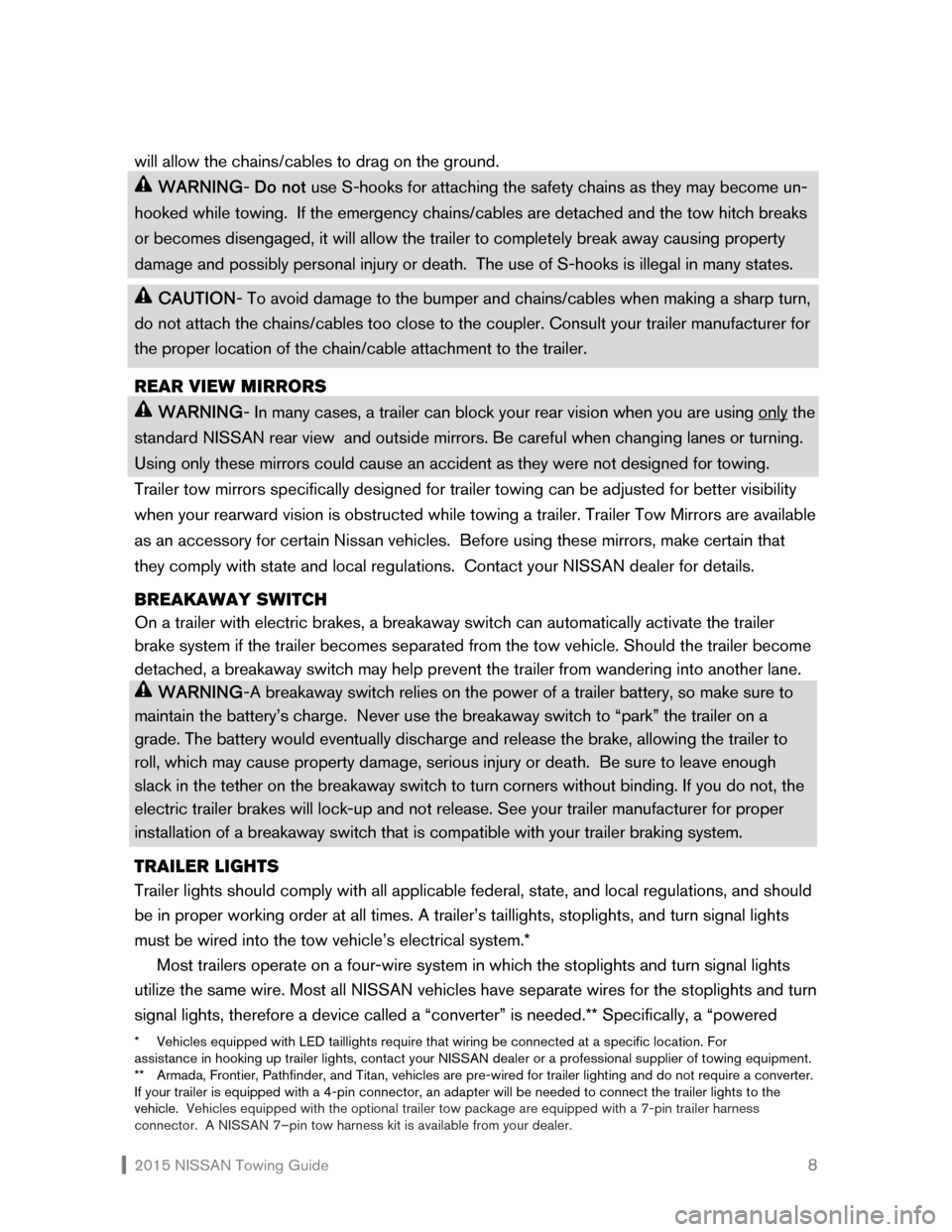
2015 NISSAN Towing Guide 8
will allow the chains/cables to drag on the ground.
WARNING- Do not use S-hooks for attaching the safety chains as they may become un-
hooked while towing. If the emergency chains/cables are detached and the tow hitch breaks
or becomes disengaged, it will allow the trailer to completely break away causing property
damage and possibly personal injury or death. The use of S-hooks is illegal in many states.
CAUTION- To avoid damage to the bumper and chains/cables when making a sharp turn,
do not attach the chains/cables too close to the coupler. Consult your trailer manufacturer for
the proper location of the chain/cable attachment to the trailer.
REAR VIEW MIRRORS
WARNING- In many cases, a trailer can block your rear vision when you are using only the
standard NISSAN rear view and outside mirrors. Be careful when changing lanes or turning.
Using only these mirrors could cause an accident as they were not designed for towing.
Trailer tow mirrors specifically designed for trailer towing can be adjusted for better visibility
when your rearward vision is obstructed while towing a trailer. Trailer Tow Mirrors are available
as an accessory for certain Nissan vehicles. Before using these mirrors, make certain that
they comply with state and local regulations. Contact your NISSAN dealer for details.
BREAKAWAY SWITCH
On a trailer with electric brakes, a breakaway switch can automatically activate the trailer
brake system if the trailer becomes separated from the tow vehicle. Should the trailer become
detached, a breakaway switch may help prevent the trailer from wandering into another lane.
WARNING-A breakaway switch relies on the power of a trailer battery, so make sure to
maintain the battery’s charge. Never use the breakaway switch to “park” the trailer on a
grade. The battery would eventually discharge and release the brake, allowing the trailer to
roll, which may cause property damage, serious injury or death. Be sure to leave enough
slack in the tether on the breakaway switch to turn corners without binding. If you do not, the
electric trailer brakes will lock-up and not release. See your trailer manufacturer for proper
installation of a breakaway switch that is compatible with your trailer braking system.
TRAILER LIGHTS
Trailer lights should comply with all applicable federal, state, and local regulations, and should
be in proper working order at all times. A trailer’s taillights, stoplights, and turn signal lights
must be wired into the tow vehicle’s electrical system.*
Most trailers operate on a four-wire system in which the stoplights and turn signal lights
utilize the same wire. Most all NISSAN vehicles have separate wires for the stoplights and turn
signal lights, therefore a device called a “converter” is needed.** Specifically, a “powered
* Vehicles equipped with LED taillights require that wiring be connected at a specific location. For
assistance in hooking up trailer lights, contact your NISSAN dealer or a professional supplier of towing equipment.
** Armada, Frontier, Pathfinder, and Titan, vehicles are pre-wired for trailer lighting and do not require a converter.
If your trailer is equipped with a 4-pin connector, an adapter will be needed to connect the trailer lights to the
vehicle. Vehicles equipped with the optional trailer tow package are equipped with a 7-pin trailer harness
connector. A NISSAN 7–pin tow harness kit is available from your dealer
.
Page 10 of 27
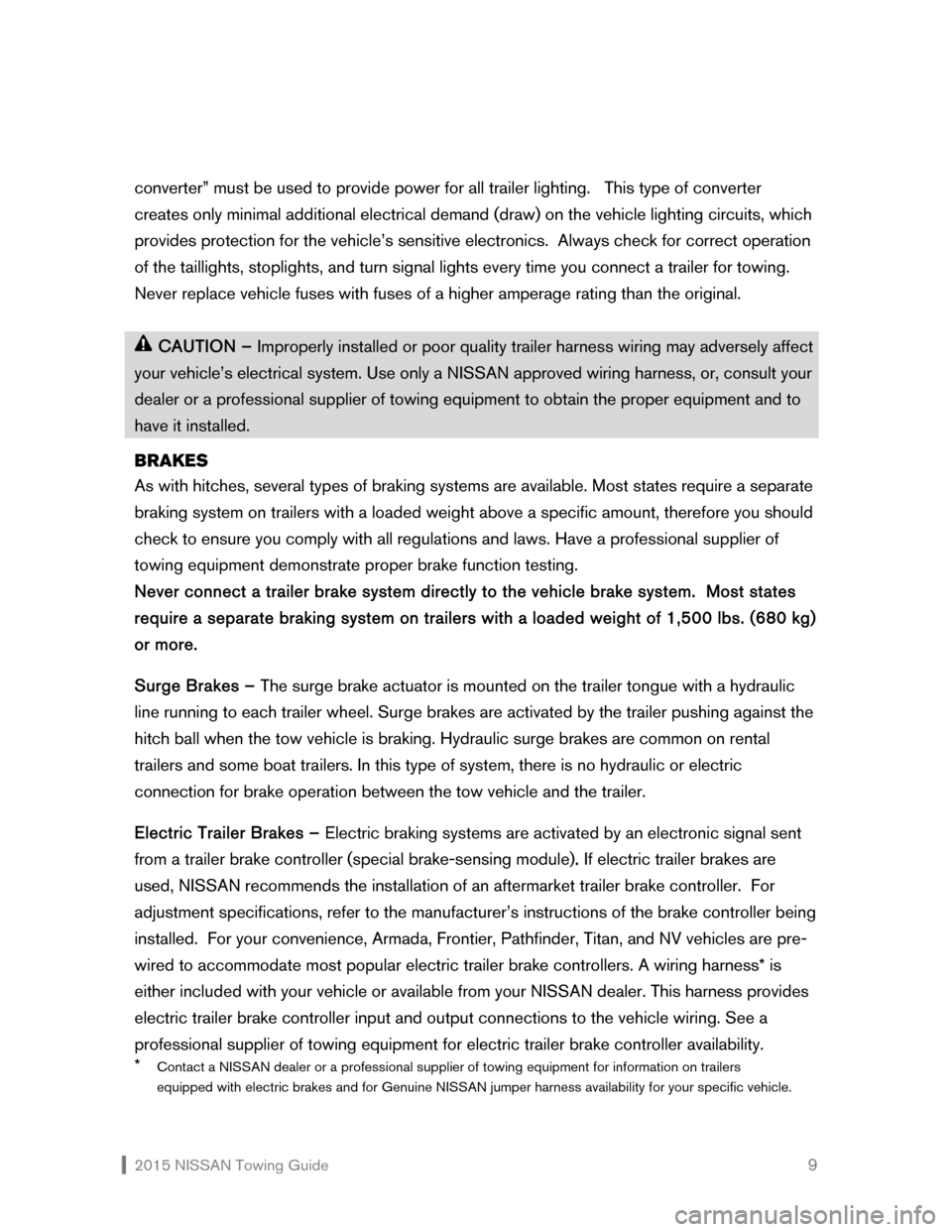
2015 NISSAN Towing Guide 9
converter” must be used to provide power for all trailer lighting. This type of converter
creates only minimal additional electrical demand (draw) on the vehicle lighting circuits, which
provides protection for the vehicle’s sensitive electronics. Always check for correct operation
of the taillights, stoplights, and turn signal lights every time you connect a trailer for towing.
Never replace vehicle fuses with fuses of a higher amperage rating than the original.
CAUTION – Improperly installed or poor quality trailer harness wiring may adversely affect
your vehicle’s electrical system. Use only a NISSAN approved wiring harness, or, consult your
dealer or a professional supplier of towing equipment to obtain the proper equipment and to
have it installed.
BRAKES
As with hitches, several types of braking systems are available. Most states require a separate
braking system on trailers with a loaded weight above a specific amount, therefore you should
check to ensure you comply with all regulations and laws. Have a professional supplier of
towing equipment demonstrate proper brake function testing.
Never connect a trailer brake system directly to the vehicle brake system. Most states
require a separate braking system on trailers with a loaded weight of 1,500 lbs. (680 kg)
or more.
Surge Brakes – The surge brake actuator is mounted on the trailer tongue with a hydraulic
line running to each trailer wheel. Surge brakes are activated by the trailer pushing against the
hitch ball when the tow vehicle is braking. Hydraulic surge brakes are common on rental
trailers and some boat trailers. In this type of system, there is no hydraulic or electric
connection for brake operation between the tow vehicle and the trailer.
Electric Trailer Brakes – Electric braking systems are activated by an electronic signal sent
from a trailer brake controller (special brake-sensing module). If electric trailer brakes are
used, NISSAN recommends the installation of an aftermarket trailer brake controller. For
adjustment specifications, refer to the manufacturer’s instructions of the brake controller being
installed. For your convenience, Armada, Frontier, Pathfinder, Titan, and NV vehicles are pre-
wired to accommodate most popular electric trailer brake controllers. A wiring harness* is
either included with your vehicle or available from your NISSAN dealer. This harness provides
electric trailer brake controller input and output connections to the vehicle wiring. See a
professional supplier of towing equipment for electric trailer brake controller availability.
*
Contact a NISSAN dealer or a professional supplier of towing equipment for information on trailers
equipped with electric brakes and for Genuine NISSAN jumper harness availability for your specific vehicle.
Page 11 of 27
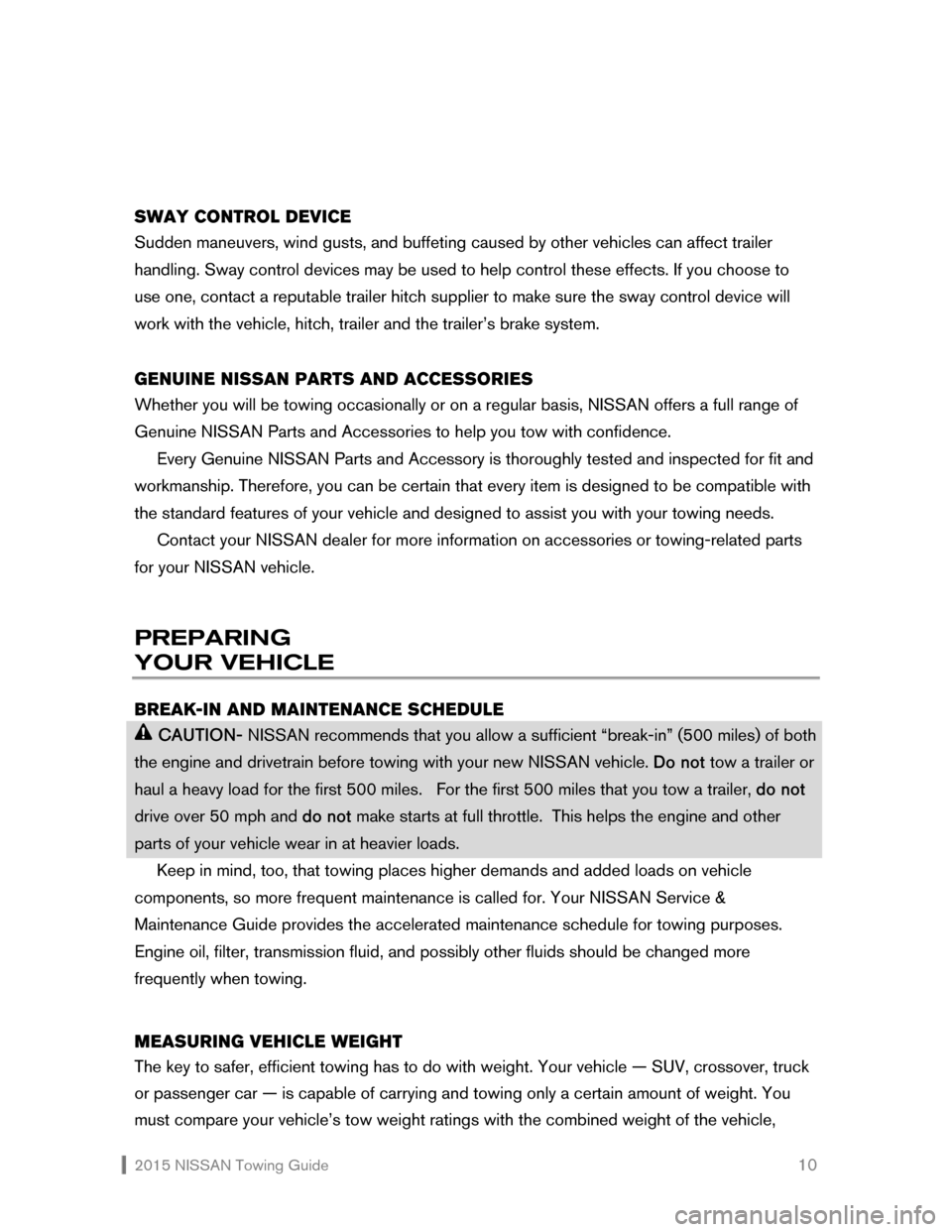
2015 NISSAN Towing Guide 10
SWAY CONTROL DEVICE
Sudden maneuvers, wind gusts, and buffeting caused by other vehicles can affect trailer
handling. Sway control devices may be used to help control these effects. If you choose to
use one, contact a reputable trailer hitch supplier to make sure the sway control device will
work with the vehicle, hitch, trailer and the trailer’s brake system.
GENUINE NISSAN PARTS AND ACCESSORIES
Whether you will be towing occasionally or on a regular basis, NISSAN offers a full range of
Genuine NISSAN Parts and Accessories to help you tow with confidence.
Every Genuine NISSAN Parts and Accessory is thoroughly tested and inspected for fit and
workmanship. Therefore, you can be certain that every item is designed to be compatible with
the standard features of your vehicle and designed to assist you with your towing needs.
Contact your NISSAN dealer for more information on accessories or towing-related parts
for your NISSAN vehicle.
PREPARING
YOUR VEHICLE
BREAK-IN AND MAINTENANCE SCHEDULE
CAUTION- NISSAN recommends that you allow a sufficient “break-in” (500 miles) of both
the engine and drivetrain before towing with your new NISSAN vehicle. Do not tow a trailer or
haul a heavy load for the first 500 miles. For the first 500 miles that you tow a trailer, do not
drive over 50 mph and do not make starts at full throttle. This helps the engine and other
parts of your vehicle wear in at heavier loads.
Keep in mind, too, that towing places higher demands and added loads on vehicle
components, so more frequent maintenance is called for. Your NISSAN Service &
Maintenance Guide provides the accelerated maintenance schedule for towing purposes.
Engine oil, filter, transmission fluid, and possibly other fluids should be changed more
frequently when towing.
MEASURING VEHICLE WEIGHT
The key to safer, efficient towing has to do with weight. Your vehicle — SUV, crossover, truck
or passenger car — is capable of carrying and towing only a certain amount of weight. You
must compare your vehicle’s tow weight ratings with the combined weight of the vehicle,
Page 12 of 27
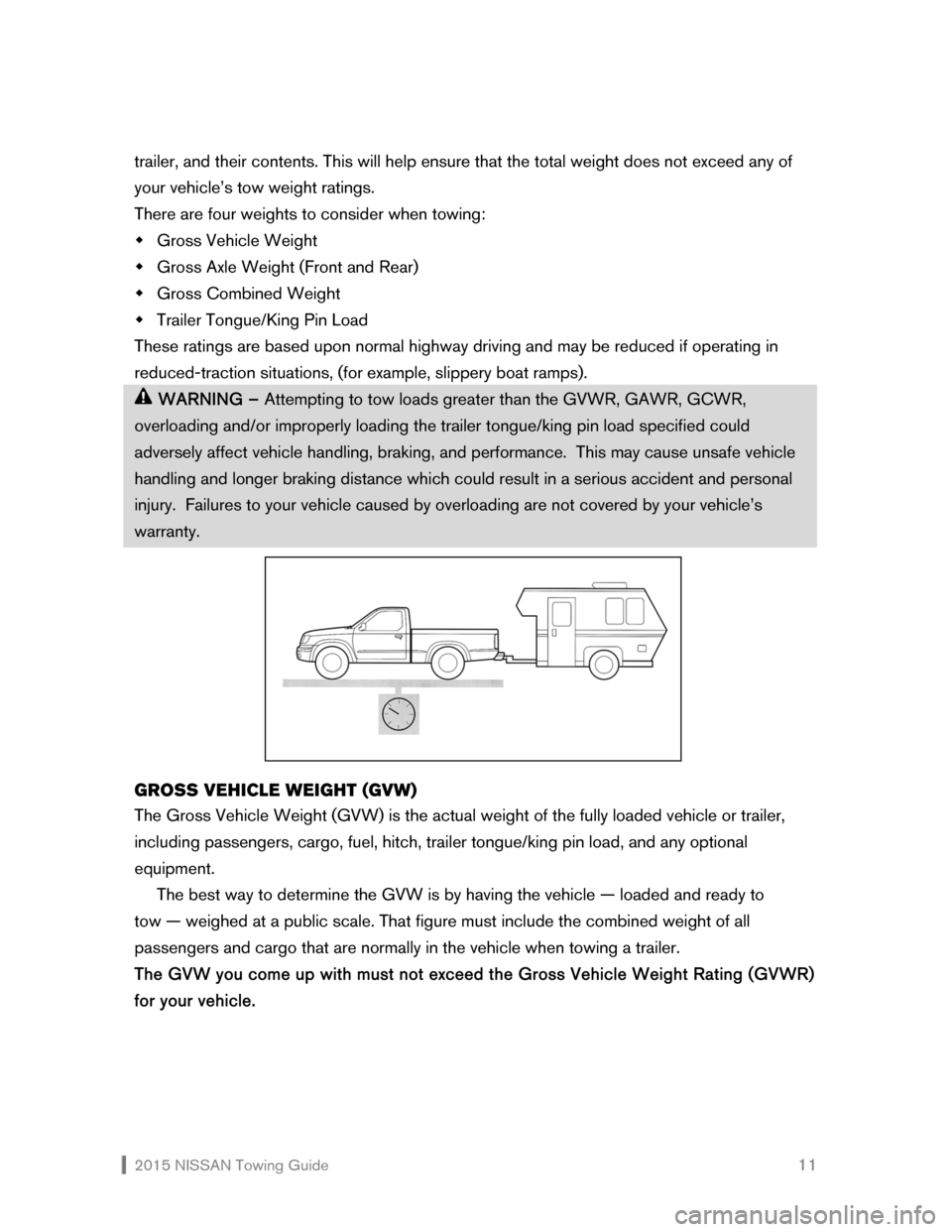
2015 NISSAN Towing Guide 11
trailer, and their contents. This will help ensure that the total weight does not exceed any of
your vehicle’s tow weight ratings.
There are four weights to consider when towing:
Gross Vehicle Weight
Gross Axle Weight (Front and Rear)
Gross Combined Weight
Trailer Tongue/King Pin Load
These ratings are based upon normal highway driving and may be reduced if operating in
reduced-traction situations, (for example, slippery boat ramps).
WARNING – Attempting to tow loads greater than the GVWR, GAWR, GCWR,
overloading and/or improperly loading the trailer tongue/king pin load specified could
adversely affect vehicle handling, braking, and performance. This may cause unsafe vehicle
handling and longer braking distance which could result in a serious accident and personal
injury. Failures to your vehicle caused by overloading are not covered by your vehicle’s
warranty.
GROSS VEHICLE WEIGHT (GVW)
The Gross Vehicle Weight (GVW) is the actual weight of the fully loaded vehicle or trailer,
including passengers, cargo, fuel, hitch, trailer tongue/king pin load, and any optional
equipment.
The best way to determine the GVW is by having the vehicle — loaded and ready to
tow — weighed at a public scale. That figure must include the combined weight of all
passengers and cargo that are normally in the vehicle when towing a trailer.
The GVW you come up with must not exceed the Gross Vehicle Weight Rating (GVWR)
for your vehicle.
Page 13 of 27
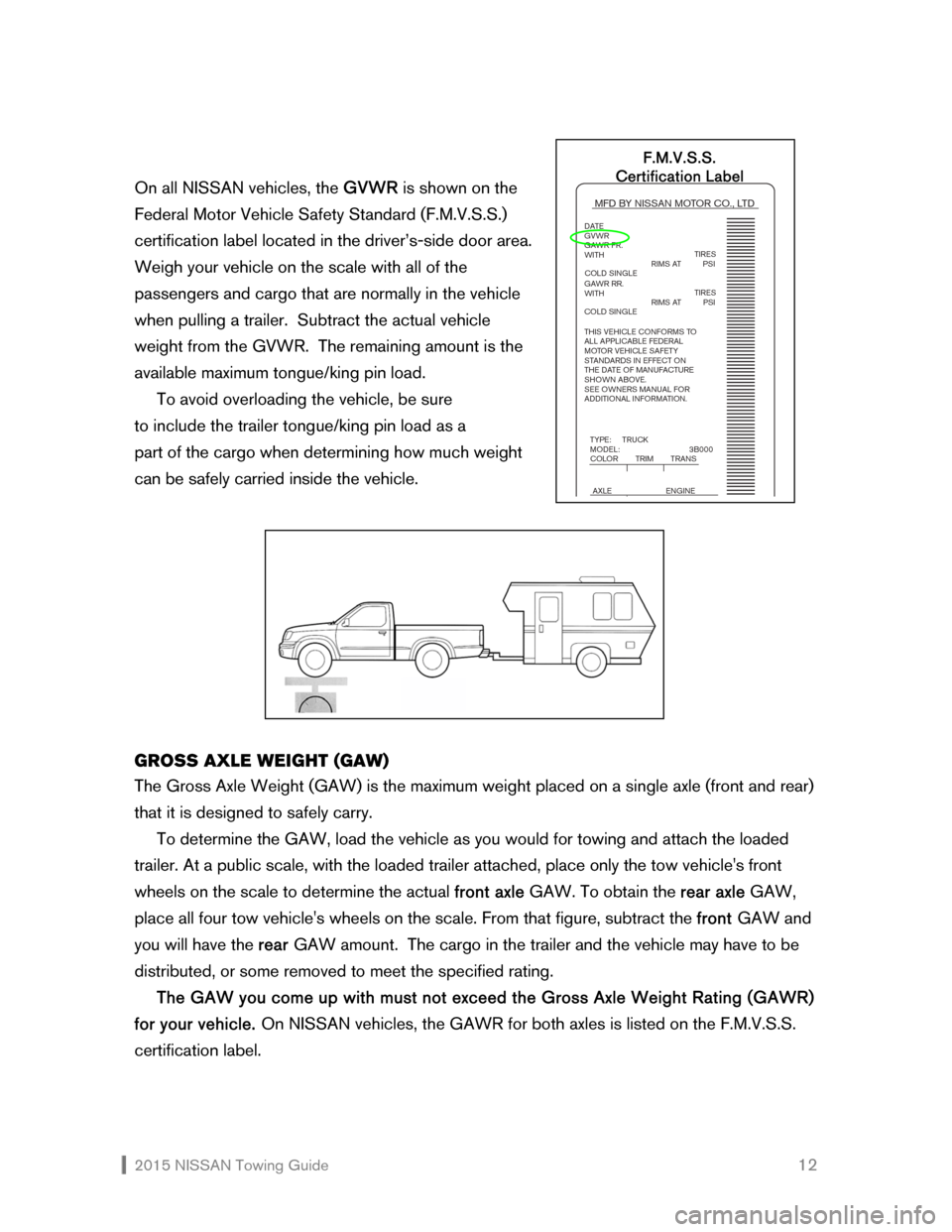
2015 NISSAN Towing Guide 12
On all NISSAN vehicles, the GVWR is shown on the
Federal Motor Vehicle Safety Standard (F.M.V.S.S.)
certification label located in the driver’s-side door area.
Weigh your vehicle on the scale with all of the
passengers and cargo that are normally in the vehicle
when pulling a trailer. Subtract the actual vehicle
weight from the GVWR. The remaining amount is the
available maximum tongue/king pin load.
To avoid overloading the vehicle, be sure
to include the trailer tongue/king pin load as a
part of the cargo when determining how much weight
can be safely carried inside the vehicle.
GROSS AXLE WEIGHT (GAW)
The Gross Axle Weight (GAW) is the maximum weight placed on a single axle (front and rear)
that it is designed to safely carry.
To determine the GAW, load the vehicle as you would for towing and attach the loaded
trailer. At a public scale, with the loaded trailer attached, place only the tow vehicle's front
wheels on the scale to determine the actual front axle GAW. To obtain the rear axle GAW,
place all four tow vehicle's wheels on the scale. From that figure, subtract the front GAW and
you will have the rear GAW amount. The cargo in the trailer and the vehicle may have to be
distributed, or some removed to meet the specified rating.
The GAW you come up with must not exceed the Gross Axle Weight Rating (GAWR)
for your vehicle. On NISSAN vehicles, the GAWR for both axles is listed on the F.M.V.S.S.
certification label.
MFD BY NISSAN MOTOR CO., LTD
DATE
GVWR
GAWR FR.
WITH
GAWR RR.
WITH
THIS VEHICLE CONFORMS TO
ALL APPLICABLE FEDERAL
MOTOR VEHICLE SAFETY
STANDARDS IN EFFECT ON
THE DATE OF MANUFACTURE
SHOWN ABOVE.
SEE OWNERS MANUAL FOR
ADDITIONAL INFORMATION.
TIRES
TIRES
TYPE: TRUCK
MODEL: 3B000
COLOR TRIM TRANS
AXLE ENGINE
RIMS AT PSI
COLD SINGLERIMS AT PSI
COLD SINGLE
F.M.V.S.S.
Certification Label
Page 14 of 27
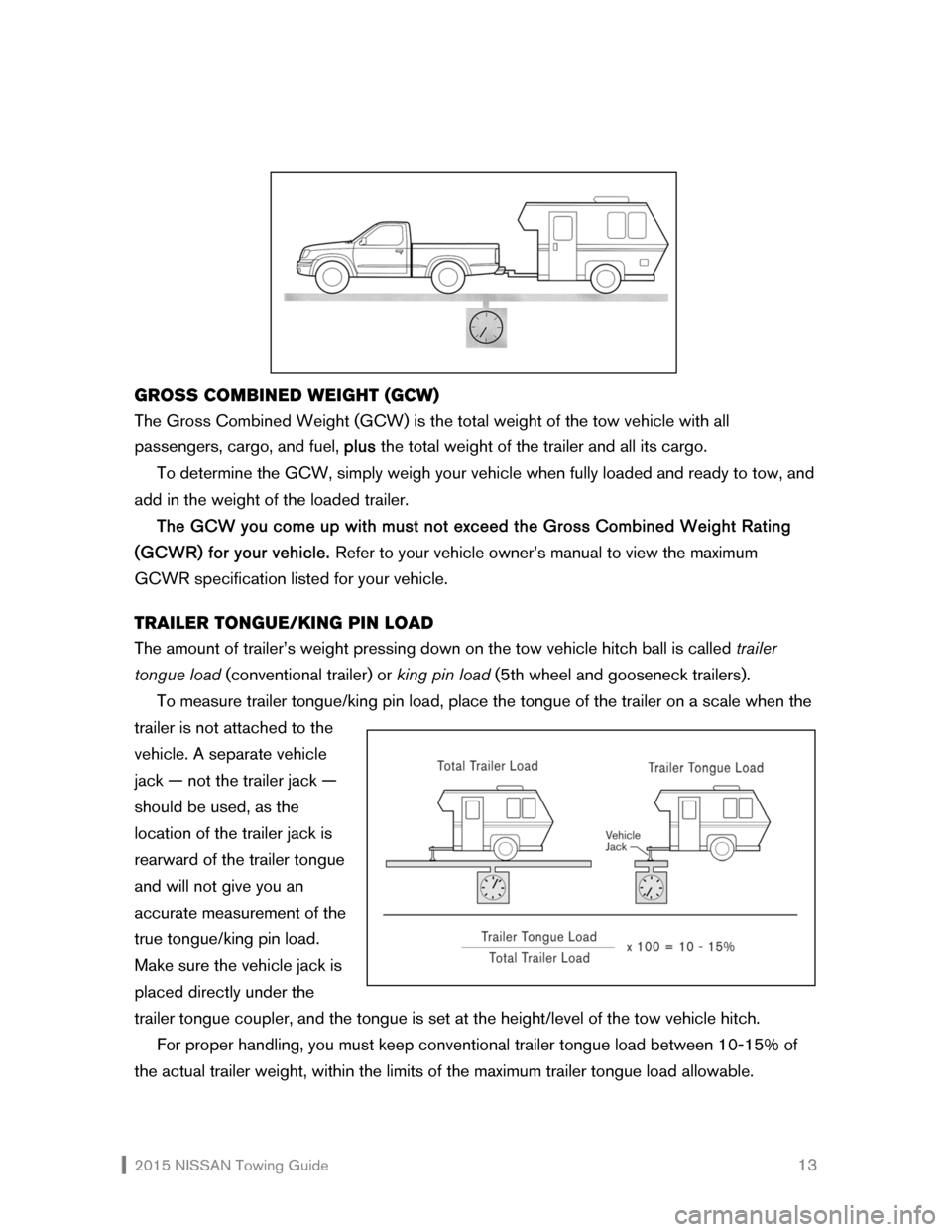
2015 NISSAN Towing Guide 13
GROSS COMBINED WEIGHT (GCW)
The Gross Combined Weight (GCW) is the total weight of the tow vehicle with all
passengers, cargo, and fuel, plus the total weight of the trailer and all its cargo.
To determine the GCW, simply weigh your vehicle when fully loaded and ready to tow, and
add in the weight of the loaded trailer.
The GCW you come up with must not exceed the Gross Combined Weight Rating
(GCWR) for your vehicle. Refer to your vehicle owner’s manual to view the maximum
GCWR specification listed for your vehicle.
TRAILER TONGUE/KING PIN LOAD
The amount of trailer’s weight pressing down on the tow vehicle hitch ball is called trailer
tongue load (conventional trailer) or king pin load (5th wheel and gooseneck trailers).
To measure trailer tongue/king pin load, place the tongue of the trailer on a scale when the
trailer is not attached to the
vehicle. A separate vehicle
jack — not the trailer jack —
should be used, as the
location of the trailer jack is
rearward of the trailer tongue
and will not give you an
accurate measurement of the
true tongue/king pin load.
Make sure the vehicle jack is
placed directly under the
trailer tongue coupler, and the tongue is set at the height/level of the tow vehicle hitch.
For proper handling, you must keep conventional trailer tongue load between 10-15% of
the actual trailer weight, within the limits of the maximum trailer tongue load allowable.
Page 15 of 27

2015 NISSAN Towing Guide 14
For example, to determine the proper trailer tongue load for a 1,500-lb. trailer, multiply the
weight of 1,500 lbs. by 10% to arrive at a figure of 150 lbs. 5th wheel and gooseneck trailer
king pin load must be kept between 15-25% of the actual trailer weight, within the limits of
the king pin load allowable.
Some trailer types may require different trailer tongue loads for safe towing. Always follow
the trailer manufacturer’s recommendations for proper trailer set-up and trailer tongue load.
Keep the trailer tongue load within the maximum trailer tongue load allowable. Additionally,
make sure the vehicle has the payload capacity available for the trailer tongue load.
Refer to your vehicle owner’s manual to view the maximum conventional trailer tongue load
listed for your vehicle.
WARNING – DO NOT exceed any of the individual vehicle weight ratings (GVWR,
GAWR, GCWR, etc.), regardless of trailer or hitch type. Overloading or improper
loading of a trailer can cause unsafe vehicle handling, braking and performance and may
lead to a serious accident and personal injury.
HITCH & TRAILER HEIGHT
It is important that your trailer floor and tongue ride as level as possible. This will help prevent
over-angling, bottoming-out, and improper tongue load and load transfer. Therefore, the hitch
or trailer tongue must be adjusted during the initial vehicle/trailer fit-up to ensure a level ride.
Ball mounts are available in different configurations to adjust the hitch ball height.
TIRE PRESSURE
When towing a trailer, ensure that the tow vehicle’s tire pressures are inflated to the
recommended cold tire specification. You will find these figures in the vehicle owner’s manual
and on the tire pressure chart located in the vehicle. Trailer tire condition, size, load rating, and
inflation pressure must be in accordance with the trailer and tire manufacturer’s specifications.
Page 16 of 27
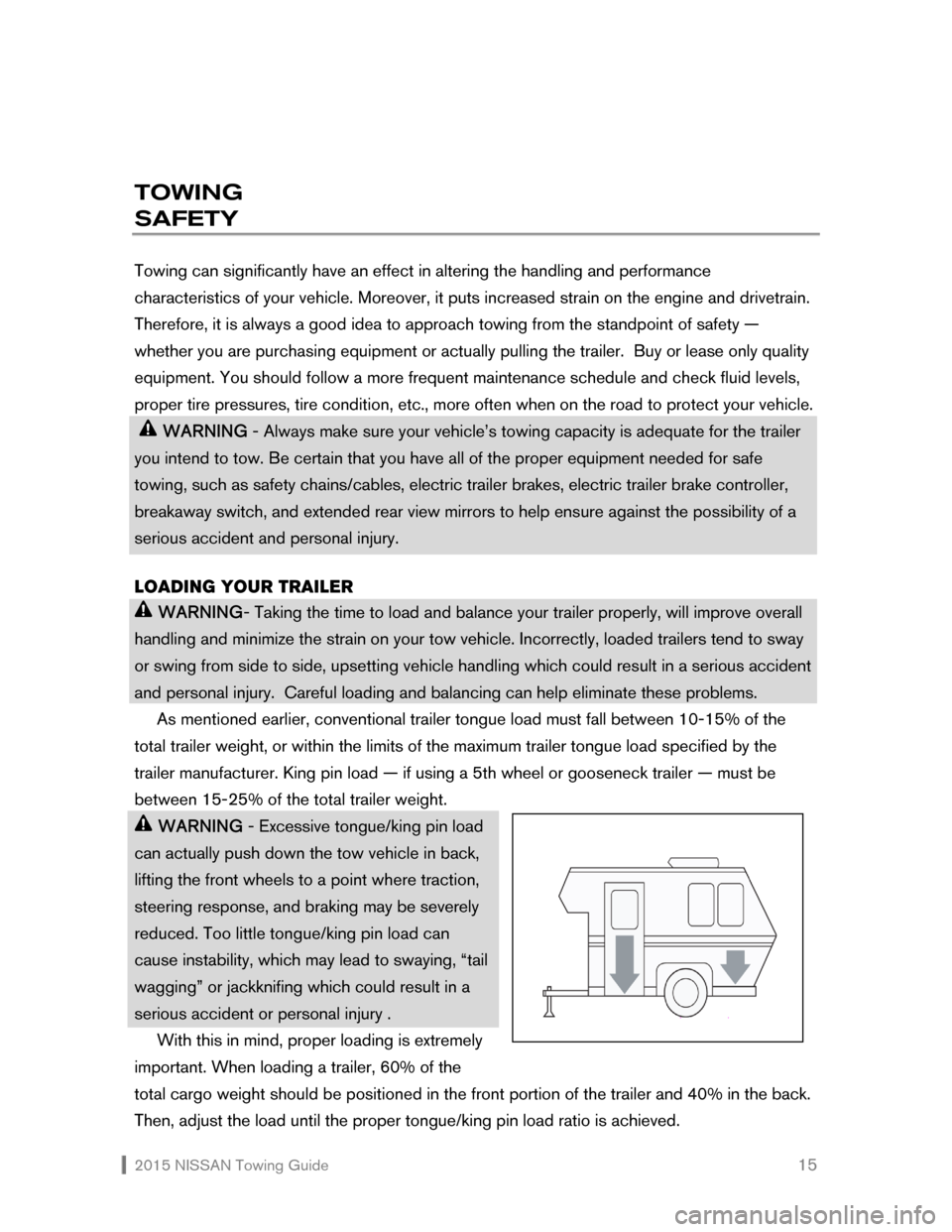
2015 NISSAN Towing Guide 15
TOWING
SAFETY
Towing can significantly have an effect in altering the handling and performance
characteristics of your vehicle. Moreover, it puts increased strain on the engine and drivetrain.
Therefore, it is always a good idea to approach towing from the standpoint of safety —
whether you are purchasing equipment or actually pulling the trailer. Buy or lease only quality
equipment. You should follow a more frequent maintenance schedule and check fluid levels,
proper tire pressures, tire condition, etc., more often when on the road to protect your vehicle.
WARNING - Always make sure your vehicle’s towing capacity is adequate for the trailer
you intend to tow. Be certain that you have all of the proper equipment needed for safe
towing, such as safety chains/cables, electric trailer brakes, electric trailer brake controller,
breakaway switch, and extended rear view mirrors to help ensure against the possibility of a
serious accident and personal injury.
LOADING YOUR TRAILER
WARNING- Taking the time to load and balance your trailer properly, will improve overall
handling and minimize the strain on your tow vehicle. Incorrectly, loaded trailers tend to sway
or swing from side to side, upsetting vehicle handling which could result in a serious accident
and personal injury. Careful loading and balancing can help eliminate these problems.
As mentioned earlier, conventional trailer tongue load must fall between 10-15% of the
total trailer weight, or within the limits of the maximum trailer tongue load specified by the
trailer manufacturer. King pin load — if using a 5th wheel or gooseneck trailer — must be
between 15-25% of the total trailer weight.
WARNING - Excessive tongue/king pin load
can actually push down the tow vehicle in back,
lifting the front wheels to a point where traction,
steering response, and braking may be severely
reduced. Too little tongue/king pin load can
cause instability, which may lead to swaying, “tail
wagging” or jackknifing which could result in a
serious accident or personal injury .
With this in mind, proper loading is extremely
important. When loading a trailer, 60% of the
total cargo weight should be positioned in the front portion of the trailer and 40% in the back.
Then, adjust the load until the proper tongue/king pin load ratio is achieved.